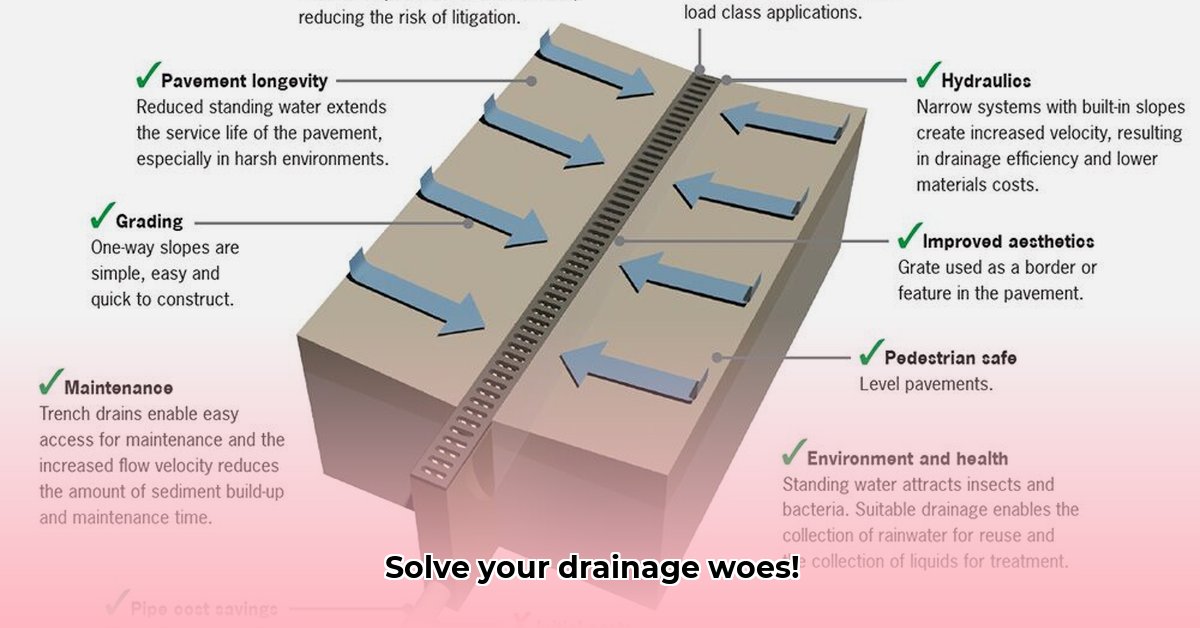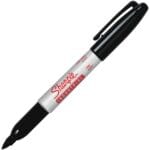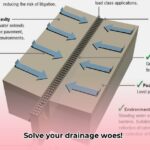Understanding Your Drainage Needs: From Puddles to Preservation
A well-functioning drainage system is crucial for maintaining a dry, healthy home and landscape. Whether battling persistent puddles, a damp basement, or simply seeking to safeguard your property from potential water damage, understanding your drainage options is the first step. This guide explores various drainage system types, simplifying the decision-making process and empowering you to choose the best solution for your property and budget. For more on effective water removal, see our guide on different types of pumps.
Surface Drainage: Managing Visible Water Flow
Surface drainage systems address water accumulation where it originates, preventing runoff from causing damage. These solutions are often the first line of defense against excess water and are typically more budget-friendly than subsurface alternatives. Let’s explore the common types of surface drainage:
Swales: These shallow, vegetated ditches seamlessly integrate with your landscape while effectively directing water away from vulnerable areas. Swales are a natural, aesthetically pleasing solution, particularly suited for gentle slopes and integrating seamlessly with existing landscaping. They can also be strategically placed to filter pollutants from stormwater runoff, further enhancing their environmental benefit. Consider native plantings for a low-maintenance and ecologically sound swale design.
Gutters and Downspouts: This essential system channels water from your roof away from your foundation, preventing basement flooding, foundation damage, and soil erosion. Regular maintenance is crucial for optimal performance. Clean your gutters at least twice a year, or more frequently if surrounded by trees. Consider installing gutter guards to minimize debris buildup and further reduce maintenance needs. Downspout extensions can further direct water away from the foundation, ensuring effective drainage.
Gravel Drains/French Drains (Surface): Simple yet effective, gravel-filled trenches, sometimes referred to as surface French drains, offer a DIY-friendly solution for localized drainage issues. These drains are easy to install and maintain, ideal for areas where water tends to pool. The gravel layer filters debris while allowing water to percolate through, preventing standing water. This option is particularly cost-effective for smaller areas or as a supplementary drainage measure.
Channel Drains: Durable and designed for high-volume water flow, channel drains are a robust solution for driveways, patios, and walkways. These systems effectively manage heavy runoff and can withstand pedestrian and vehicular traffic. Constructed from materials like concrete, polymer concrete, or plastic, they offer varying levels of load-bearing capacity to suit specific applications. Grates are typically incorporated to enhance safety and aesthetics, while also preventing debris from clogging the system.
Paved Channels/Sheet Flow: For expansive paved surfaces, sheet flow directs water across the surface towards designated drainage points. This design incorporates a subtle slope to facilitate drainage, minimizing ponding and preventing large-scale water accumulation. This is a common strategy in parking lots and other large paved areas where concentrated drainage solutions aren’t feasible. Proper grading is critical to ensure uniform water flow and prevent localized pooling
Subsurface Drainage: Addressing Hidden Water Problems
Subsurface drainage systems operate underground, tackling issues like high water tables, saturated soil, and hydrostatic pressure against foundations. While less visible than surface drainage, these systems are critical for maintaining a dry foundation and healthy landscape. Here are the key subsurface drainage methods:
French Drains (Subsurface): A classic and reliable solution, subsurface French drains consist of perforated pipes buried in gravel-filled trenches. These pipes collect and redirect subterranean water away from your home’s foundation, preventing basement seepage and structural damage. Properly sloped trenches and strategically placed outlet points are crucial for effective drainage.
Perforated Pipes/Drain Tile: Used independently or within a French drain system, perforated pipes, often called drain tile, efficiently channel water away from problem areas. These pipes, typically made of PVC or corrugated plastic, are placed in trenches surrounded by gravel to facilitate water collection and prevent clogging. Their versatility allows for customized solutions to address specific water flow patterns.
Dry Wells: These underground chambers collect water, allowing it to gradually infiltrate into the surrounding soil. Dry wells are a less intrusive alternative to extensive piping systems, managing localized water buildup effectively. They are especially beneficial for areas where discharging water directly to a storm drain or other outlet is not feasible. Proper sizing and placement are essential for optimal dry well performance.
Foundation Drains/Footing Drains: Specifically designed to protect building foundations, footing drains are installed around the perimeter of the foundation during construction. These perforated pipes capture water that would otherwise accumulate against the foundation walls, preventing seepage, cracks, and structural damage. They are essential in areas with high water tables or heavy clay soils. Regular inspection and cleaning are recommended to maintain their effectiveness.
Sump Pumps: Often used in conjunction with French drains or footing drains, sump pumps actively remove accumulated water from a sump pit, a designated collection point below your basement floor. These pumps automatically activate when water levels rise, preventing basement flooding. Regular maintenance and battery backups are essential to ensure reliable operation during power outages.
Choosing the Right System: A Tailored Approach
Selecting the right drainage system requires a thorough understanding of your property’s unique characteristics. Factors like soil type, rainfall intensity, land slope, budget, and aesthetics all play a significant role.
Step-by-Step Guide to Choosing Your Drainage System:
Property Assessment: Carefully analyze your property’s drainage patterns. Observe where water accumulates during and after rainfall. Evaluate your soil type – clay soils retain water, while sandy soils drain quickly. Determine the topography of your land, noting slopes and low-lying areas.
Drainage Goals: Define your specific needs. Are you addressing basement seepage, yard flooding, or simply seeking preventative measures? Understanding your goals will guide your system selection.
System Requirements: Based on your assessment and goals, determine if you need surface drainage, subsurface drainage, or a combination of both. For instance, gutters and downspouts might be sufficient for roof runoff, while a French drain might be necessary for a persistently wet yard.
System Selection: Research specific systems within your chosen category. Consider cost, effectiveness, aesthetics, and maintenance requirements. Compare materials and designs to find the best fit for your needs.
Professional Consultation (Highly Recommended): For complex projects or if you’re unsure about the best approach, consult a drainage professional. They can accurately assess your property, recommend tailored solutions, and ensure proper installation.
Regulatory Compliance: Research and adhere to local building codes and regulations regarding drainage systems. Obtain necessary permits before starting any installation work.
Installation and Maintenance: Proper installation is critical for long-term performance. Follow manufacturer guidelines or hire a qualified contractor. Once installed, regularly clean and inspect your drainage system to prevent clogs and ensure its continued effectiveness. This may involve flushing gutters, clearing debris from drains, and periodically checking sump pump operation.
By taking a proactive approach and selecting the right drainage system, you can protect your property from water damage, maintain a healthy landscape, and enjoy peace of mind knowing you’re prepared for whatever weather comes your way. Remember, proper drainage is an investment that benefits both your property and your well-being.
- China II Review: Delicious Food & Speedy Service - April 17, 2025
- Understand Virginia’s Flag: History & Debate - April 17, 2025
- Explore Long Island’s Map: Unique Regions & Insights - April 17, 2025
















